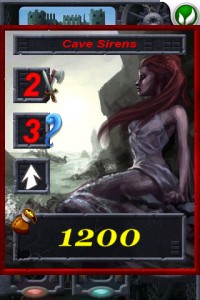Welcome to Purple Pawn, covering games played around the world by billions of people every day.
 This isn’t a Second Look in the traditional sense on Purple Pawn, as we haven’t previously covered any news of the game before. I have, however, heard much about this game on The Dice Tower, and decided it was worth looking into.
This isn’t a Second Look in the traditional sense on Purple Pawn, as we haven’t previously covered any news of the game before. I have, however, heard much about this game on The Dice Tower, and decided it was worth looking into.
Dungeon Solitaire is a card game for the iPhone created by Griptonite Games, the company that also put out the fantastic iPhone version of Reiner Knizia’s Poison. The game and it’s interface are very professional, well made, and polished. The object of the same is simple, get 5 heroes into your hero column, then draw another hero to win.
Of course, it’s VERY hard to do this.
Let’s talk a bit about how the game board is set up. On the left of the screen you have the monster column. To the right of that is the hero column. Above those two columns is you castle. On the right side of the screen is the draw pile, a place to show the current card you’ve drawn, and a discard pile used to place items you cannot use.
Every turn you’ll draw a card. The card may be a monster, hero, item, enchantment, or trap. Monsters and heroes have 3 boxes on them. The first box is the attack power of the monster/hero, while the second is the magic power. The third box is designated for a special power, which not every monster/hero has. More on this later.
Items, enchantments, and traps generally have 2 boxes on them. These are modifiers to attack and magic. Each hero can equip only 1 item, and that’s it. Enchantments can be played on any hero, and traps are played into a column, and they’re effects take place on whatever card is placed on top of them.
Now let’s get more into the game itself.
After drawing a card, you have to use it. If it’s a monster, you place it in the monster column. The column can hold up to 5 monsters. If you draw a monster while the column is full, the creature hits your castle and does damage. Do this 3 times and you lose. If you draw a hero, you place it in the hero column, which also holds 5 cards. Fill this, draw one more hero, and you win. If you place a hero and a monster next to each other, they battle. If one card’s numbers are BOTH higher than the other, that card wins, otherwise the cards draw.
2 things can happen when cards draw:
1. Nothing
2. The attacking card’s special power is activated.
Special powers come into play a LOT during the game, and are where any real strategy comes in. There are several powers a card can have. Sometimes a card will bump it’s opponent up or down in the column, forcing any other cards it pushes in the same direction. Some special powers spawn a copy of the current card, and some even outright destroy any card that creature/hero ties with. There’s a few others, but I haven’t really figured out what they do yet.
Each creature you defeat gives you gold, which is basically your score. Winning the game gives you a bonus, and there’s a high score chart and online leader boards so you can see how well you’ve done against other players.
I’ve already written a lot about the game, and there’s probably more still to write on the various power ups, strategies, expansion decks, and more. In the end, i’d HIGHLY recommend snagging Dungeon Solitaire from the iTunes App Store. The game is quick, addictive, and fun. There’s a few free card expansions, and a few paid expansions that add all sorts of new things to your deck. One of the best things about Dungeon Solitaire is the price. It’s only $1.99. Not too shabby for such a great game.
Promotional consideration was given by Griptonite games in the form of a free copy of Dungeon Solitaire.
No Comments
Sorry, the comment form is closed at this time.
Trending
- Massdrop.com
- Oh the Irony—Illuminati Card Game Continues to Inspire Conspiracy Theorists
- Footprints, an Educational Ecology Game
- USPS Adds Board Game Flat Rate Box
- Home
- Baila, the Estonian Drinking Card Game
- Crystal Caste Wins Dice Patent Suit Against Hasbro
- Mirror Game, Red and Blue
- Hasbro and Mattel Merger?
- Are Board Games Dangerous?
Archives
Most Popular Articles
- Oh the Irony—Illuminati Card Game Continues to Inspire Conspiracy Theorists
- The 20 Most Valuable Vintage Board Games
- The Truth About Dominoes On Sunday in Alabama
- Sequence Game, and Variants
- USPS Adds Board Game Flat Rate Box
- Baila, the Estonian Drinking Card Game
- The 13 Most Popular Dice Games
- Are Board Games Dangerous?
- Guess Who? The Naked Version
- What Happened to the Jewel Royale Chess Set?
Recent Posts
- Toy Fair 2019—Breaking Games
- Talisman Kingdom Hearts Edition
- Toy Fair 2019—Winning Moves
- Toy Fair 2019—Games Workshop
- Toy Fair 2019—Star Wars Lightsaber Academy
- Toy Fair 2019—Stranger Things Games
- Toy Fair 2019—HABA
- Licensing Roundup
- Game Bandit
- 2018 A Difficult Year For Hasbro But Not For D&D Or MtG
Recent Comments
- on Toy Fair 2019—Winning Moves
- on Game Bandit
- on Second Look—Dungeons & Dragons Waterdeep Dragon Heist
- on Crowdfunding Highlights
- on Beyblade SlingShock
- on Game Bandit
- on Game Bandit
- on Watch This Game!, the Board Game Review Board Game
- on Second Look—Vampire: The Masquerade 5th Edition
- on Palladium Books Loses Robotech IP License, Cancels Five-Year-Overdue Robotech RPG Tactics Kickstarter




